CATHEDRAL QUARTER TRAILS - MARKETPLACE
DERBY CATHEDRAL QUARTER – 7 MARKETPLACE
Stylish, independent shops, great places to eat and drink, valued professional services and impressive historical landmarks; Derby’s Cathedral Quarter has it all.
Looking across Derby Marketplace

A market may have existed in Derby’s Marketplace as early as 1100AD. The town’s first Market Charter was not particularly detailed. But the second, granted fifty years later, in 1204 by King John was much more precise. This Charter allowed a weekly market, held from Thursday to Friday evening and granted the Burgesses the right to levy tolls from the traders, as well as punish thieves. Later additions to the Charter gave the rights to hold fairs at Easter, Whitsun and Michaelmas.
The Marketplace was once much smaller than it is today, with space opposite the old town hall occupied by a collection of buildings including The Piazzas and The Shambles. The former was built in 1708, composed of a long row of classically styled buildings, with shops on the ground floor and a covered walkway in front. The Shambles was occupied by butchers, the word derived from the Saxon word ‘Fleshammels’, meaning street of butchers.’
By the mid-19th century, a great deal of concern was being expressed about the unsanitary conditions of the butchers’ shops and public houses in that area. It was decided that demolition was the answer to improve the design and layout of Marketplace. The task was completed in the 1870s and the square was cobbled with wooden blocks, some of which remain today in the entrance to the Market Hall.
Royal Charters
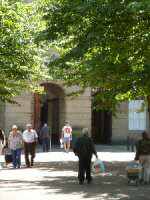
In 2004, Derby celebrated the anniversary of two Royal Charters. The first marked the 850th anniversary of King Henry’s Charter given to the Borough of Derby in 1154 and the second the 800th anniversary of King John’s Charter.
The first Assembly Rooms to be built were in Full Street, and opened in 1714. Soon the buildings were deemed unsuitable, and the Duke of Devonshire provided a site for the new Assembly Rooms in the northeast corner of Marketplace. Built-in the mid-1700s, it became trendy, but was badly damaged by fire in 1963 and subsequently demolished and replaced by the current Assembly Rooms.
The Marketplace served several purposes; public meetings took place there, particularly at election time. It was also a place where criminals were exhibited and shamed. In 1757, a woman was whipped in public for pretending to be deaf and dumb in court. Fifteen years later, Thomas Bott, a farmer, sold his wife to a man from Langley Common for eighteen pence. He completed the deal by taking her to the purchaser at the Market Place with a halter around her waist.
The market moved to the Morledge in 1933, and for a time the Market Place was a hub for public transport. Where shoppers, workers, visitors, school children and other users are caught or alighted from buses. The end of vehicular access to Market Place came in 1992 when the Derby Promenade Scheme changed the face of much of the centre of Derby. As a result, Market Place was pedestrianised.
Looking down the Corn Market

The Market Place almost certainly did not come into existence earlier than about 1100 according to recent excavations. An ancient trackway used to run along the south side of where Derby Market Place now stands and was in existence many years before the town became part of the landscape.
It was a focal point, both for trade and for social purposes, where shoppers and traders would exchange gossip as well as goods. It allowed producers to sell directly, and cut out profiteering middlemen as well as keeping prices down.
Markets sprang up rapidly after the Norman Conquest. In the Corn Market grain was traded; at the top end of Friar Gate, farm animals were bought and sold along with produce. A market was also developed on the Morledge, where fairs were held. Until the 19th century, most of the market trading took place in the Old Market Square, which was much smaller than the present one.
Now that traffic has been removed it has been used as an event space. An ice-skating rink has proved a very popular attraction, and the Big Wheel created quite a stir when it was first brought to Derby. But markets are not forgotten and regular monthly Farmers’ Markets are still held. The market has increased in size recently. Here you will find cheeses, meats, vegetables, bread, pies, cakes, plants and many other country delights. Also, speciality markets take place from time to time.
Assembly Rooms
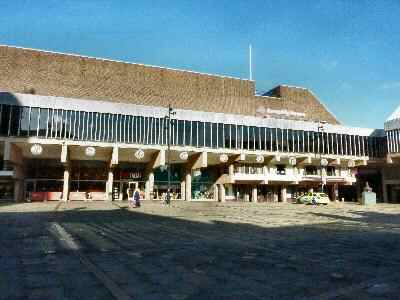
A large part of the top side of Market Place is taken up by the Assembly Rooms, which were built by Casson, Conder and Partners between 1973 and 1977. The building was designed to contain a large hall, a small hall with bars and coffee shops separated by spacious foyers. Part of the elaborate plaster Jacobean ceiling from the former Assembly Rooms has been preserved and repositioned in the reception foyer outside the Darwin Suite. It was opened by the Queen Mother, with the opening concert performed by the Royal Philharmonic Orchestra.
The present Assembly Rooms have been preceded by two others, the first one was in Full Street, which opened in 1714. It was very exclusive and was conducted by Lady Patronesses drawn from notable local families, who ensured it remained so. However, it was rather small and not of particularly striking appearance and as a result, it was not long before it was not considered suitable for the assemblies. The building was later converted into a permanent theatre, which became known as the ‘Little Theatre in Full Street’.
The Duke of Devonshire provided a site for the new Assembly Rooms on the north side of Market Place. Built-in 1752-5, but gutted by fire in 1963 and replaced. The stone façade of the previous Assembly Rooms was re-erected at Crich Tramway Museum, now renamed Crich Tramway Village.
The former Assembly Rooms was one of Derby’s very finest buildings and became very popular with members of both sexes. It was unusual in that era for both men and women to attend public entertainment simultaneously. There were strict rules on dress and single women had to be chaperoned.
Following a fire on Friday 14 March 2014, the current Assembly Rooms closed for an indefinite period.
Quad
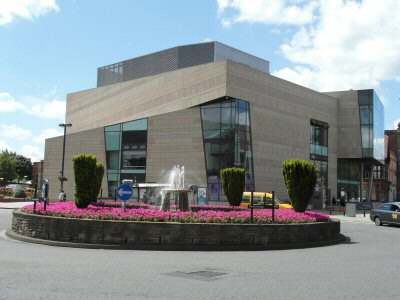
The Quad opened in September 2008 and is proving very popular with Derby people and visitors alike. It is an £11 million purpose-built centre for art and film, with a gallery, two cinema screens, a café bar and a workshop that anyone can use. It was formed when two well-known arts organisations; Q Arts and Metro Cinema, joined forces with Derby City Council to create a cultural partnership.
It is a registered independent charity that receives funding from Derby City Council and Arts Council England, as well as generating income itself, to support its charitable aims to create opportunities for entertainment, education and participation. Quad’s activities generate millions in terms of additional and direct spending with local suppliers as well as positive national and international media coverage for Derby. Due to financial problems opening hours and services were cut-back in 2024.
Guildhall
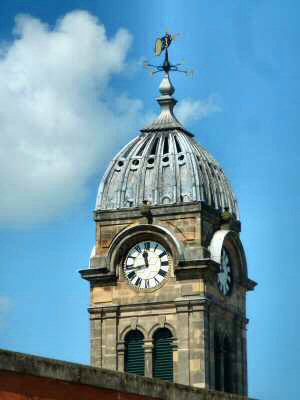
The Guildhall was built in 1730 on the site of the previous hall. In 1825, the Derby Improvement Act required it to be rebuilt and a new Guildhall was built three years later. It was designed by Matthew Habershon and constructed for £7,000 in a Grecian style and housed the Court of Sessions.
On 21 October 1841, it burnt down, leaving only the outside walls. Henry Duesbury, a local man, was commissioned to design a replacement, which included a 103-foot-high clock tower that rang out regular time checks every 15 minutes.
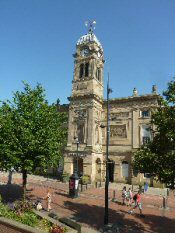
At one time the Guildhall was the home of the Council Chamber and police cells. Now the former Council Chamber with its elaborately plastered ceiling is occupied by a small theatre and concert hall. It holds several concerts, plays and recitals. On the ground floor, a regular programme of exhibitions takes place.
Along with the Assembly Rooms, the Guildhall has in the past hosted the CAMRA Real Ale Beer Festival. Derby has been the Real Ale Capital of England since its foundation in 1971; CAMRA has been extremely successful in promoting quality, choice and value for money and preventing the takeover of small breweries. No new ale breweries were set up in the UK for the 50 years before CAMRA was founded. There are now well over 1.000 new brewers producing real ale, forming part of a massive real ale revival. Beer Festivals are now also held at the Roundhouse. The Guildhall closed in early 2019 for repairs.
War Memorial
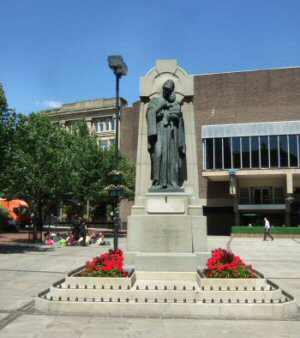
The War Memorial is made up of bronze figures on a stone plinth with a stone cross at the rear. It was unveiled on 11 November 1924, by Alderman Oswald Ling, to commemorate those from Derby who had lost their lives during the First World War. Additional plaques have been added to honour those who died during the Second World War and more recent conflicts.
The memorial was repositioned, in 1994, as part of the Derby Promenade street improvement works. Charles Clayton Thompson was the memorial’s designer and A G Walker, ARA, was responsible for the carving.
Waterfall feature

In an area reserved for relaxation, where visitors can sit and rest, The Waterfall provides a most unusual feature. It was constructed as part of the City Council, ‘Derby Promenade’, a scheme that stretched from the Spot to the Cathedral, involving pedestrianisation of the route.
The Waterfall came in for a lot of criticism, but not from the younger generation who love it, particularly when the weather is warm and the sun is shining. It has also provided a reason for an annual Well Dressing to be started in Derby, which seems fitting in a county where ‘Well Dressing’ still flourishes so strongly. Climb up the steps at the side of the Waterfall for a good view of the Marketplace and surrounding streets.
Franceys’s Town House
Located on the Iron Gate side of Market Place, Franceys’s House particularly attracts the eye. It is one of Derby’s most magnificent buildings, built in c1694 for Alderman William Franceys, a well-to-do Alderman and apothecary. He was the only tradesman to be allowed to attend the very select County Assembly. An exception was made in his case, probably because he looked after the health of the county gentry.
The house was an eight-bay, four-storey dwelling with two massive reception rooms on the first floor, now divided. The frescoed ceilings were the work of Francis Bassano.

